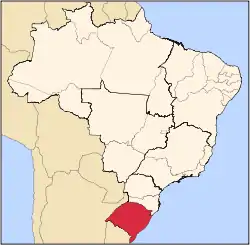Bento Gonçalves, Rio Grande do Sul
Bento Gonçalves (Portuguese pronunciation: [ˈbẽto ɡõˈsawves]) is a municipality located in the state of Rio Grande do Sul, Brazil. Created in 1875, it is one of the centers of the Italian immigration in Brazil. It is also known as the 'wine capital of Brazil' due to its vineyards and wine production. In 2020, its estimated population was 121,803 inhabitants.
Bento Gonçalves | |
|---|---|
| Municipality of Bento Gonçalves | |
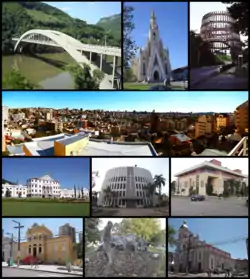 | |
 Flag 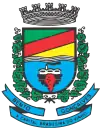 Coat of arms | |
| Nickname(s): Capital of the wine | |
 Location in Rio Grande do Sul | |
 Bento Gonçalves Location in Brazil | |
| Coordinates: 29°10′15″S 51°31′08″W | |
| Country | |
| Region | South |
| State | |
| Founded | 11 October 1890 |
| Government | |
| • Mayor | Guilherme Pasin (PP) (2013-2016) |
| Area | |
| • Total | 382.513 km2 (147.689 sq mi) |
| IBGE/2002[1] | |
| Elevation | 690 m (2,260 ft) |
| Population (2020 [2]) | |
| • Total | 121,803 |
| • Density | 280.62/km2 (726.8/sq mi) |
| Time zone | UTC-3 (BRT) |
| • Summer (DST) | UTC-2 (BRST) |
| Postal Code | 95700-000 |
| Area code(s) | +55 54 |
| Website | bentogoncalves.rs.gov.br |
Ernesto Geisel, President of Brazil from 1974 to 1979 (under the military government), was born in Bento Gonçalves in 1907.
Etymology
The city changed names three times in history. Before the Italian immigration began, the place where the city downtown is located today was crossed by horsemen, and since there was well known north–south trail with a little wooden cross at the place, the name "Cruzinha" was used to name this region.[3] After a decree of the effective governor of the province in 1870 decade, settlement Colônia Dona Isabel was named after the Brazilian princess Isabel de Bragança.[4] At 1890, Colônia Dona Isabel emancipates from Montenegro, 45 years after the end of the Farroupilha Revolution, what makes the government at the time to give the name Bento Gonçalves to the city, named after Bento Gonçalves da Silva the main leader of the Farroupilha Revolution.
History


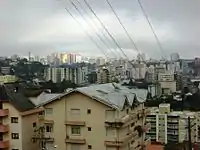
Before 1870, the area where the city is located was known as Cruzinha. It was inhabited, as the rest of the region, by Indigenous people of the "jê" tribe.
In 1875, the Brazilian government created, in the state of Rio Grande do Sul, four settlements to receive Italian immigrants. In the Cruzinha area, a settlement was created called Dona Isabel. "Dona Isabel" received the first 25 families of Italian settlers in that same year. They mostly came from the region of Trento.
During the next few decades, the region was settled by immigrants coming mostly from the Italian regions of Veneto, Trentino, and Lombardia.
In 1890, Dona Isabel was elevated to the category of city, changing its name to Bento Gonçalves (named after the military leader of the Ragamuffin War).
The Italian immigrants mostly worked in grape and wine production.
During the first few decades of the 20th century, the city continued to receive immigrants. Besides the Italians, there were large groups of Polish, German, Swedish, French, and Spanish immigrants.
At that time, there were already some functioning wine factories and the furniture and metallurgic industry was just starting to take off.
The railways arrived at the city in 1919, helping to connect it with the capital of the state, Porto Alegre, and facilitating the transport of the city's economic production. There were regular passenger trains running until 1976; however, today the railways are used mostly to transport goods.
The electric light distribution system was installed between 1919 and 1927. The Bartolomeu Tacchini Hospital was built during the same period.
In 1950, the population was 22,600. Industrial activity expanded, especially in the wine, furniture, leather, chemical, metal, and mechanical sectors.
In 1967, the city organized the first National Wine Festival (Fenavinho), receiving, for the first time, a visit from a Brazilian President.
The city started to organize and receive many important national and international events. It is now home to the second largest exposition park in Latin America. Among these events are the Movelsul (Furniture Fair), FIMMA Brasil (Furniture Machinery Fair), Vino Brasil (Wine Machinery Fair), Avaliação Nacional de Vinhos (National Wine Assessment), Fenavinho e Expobento (Commercial Fair).
Economy
Bento Gonçalves is among the ten largest economies in Rio Grande do Sul. It is the largest producer of wine in Brazil and has the second largest furniture production industry in the country. It also has important metal, mechanical, plastic, and chemical industries. It has the highest Human Development Index of Rio Grande do Sul and the sixth among all Brazilian cities - 0,870 (PNUD/2000).
Geography
The average elevation of Bento Gonçalves is 690 meters above the sea level. Summers are warm and winters are mild. During the climatic winter frosts are common and snow is rare. The highest temperature officially recorded in the city was 36 °C and the lowest was -4,5 °C.
Tourism
The Maria Fumaça steam locomotive offers tourist trips in the rolling countryside of Bento Gonçalves, Garibaldi and Carlos Barbosa.
Museums about the Italian heritage of the city include the Epopéia Italiana.
The city is also part of Vale dos Vinhedos, a region with 82 km square located at the limits of Garibaldi, Monte Belo do Sul and Bento Gonçalves. Many restaurants and wineries can be found at Vale dos Vinhedos, making the region a well known enotourism route in Brazil.

Twin towns – sister cities
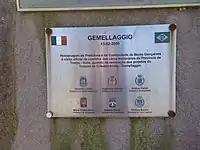
Bento Gonçalves is twinned with:[5]
 Brentonico, Italy
Brentonico, Italy Cartaxo, Portugal
Cartaxo, Portugal Isera, Italy
Isera, Italy Luján de Cuyo, Argentina
Luján de Cuyo, Argentina Mori, Italy
Mori, Italy Nogaredo, Italy
Nogaredo, Italy Rovereto, Italy
Rovereto, Italy Terragnolo, Italy
Terragnolo, Italy Trambileno, Italy
Trambileno, Italy Villa Lagarina, Italy
Villa Lagarina, Italy
Main reasons for twinning with Italian municipalities are Italian immigration history and enotourism.
References
- Brazilian Institute of Geography and Statistics - IBGE (10 October 2002). "Área territorial oficial" (in Portuguese). Retrieved 5 December 2010.
- IBGE 2020
- "The Story of the city that was once called Cruzinha" (in Portuguese). Jornal Cruzeiro. Archived from the original on 24 June 2018. Retrieved 2 August 2018.
- CAPRARA, Bernardete Schiavo (2005). Da colônia Dona Isabel ao município de Bento Gonçalves (in Portuguese). p. 583.
- "Cidades Irmãs". bentogoncalves.rs.gov.br (in Portuguese). Bento Gonçalves. Retrieved 22 May 2020.
External links
| Wikivoyage has a travel guide for Bento Gonçalves. |
- (in Portuguese) City's website
- (in Portuguese) City's search site BentoFacil
- (in Portuguese) City Map of Bento Gonçalves
- (in English) Bento Gonçalves travel page
- (in English) History of Italian Immigration to Brazil
